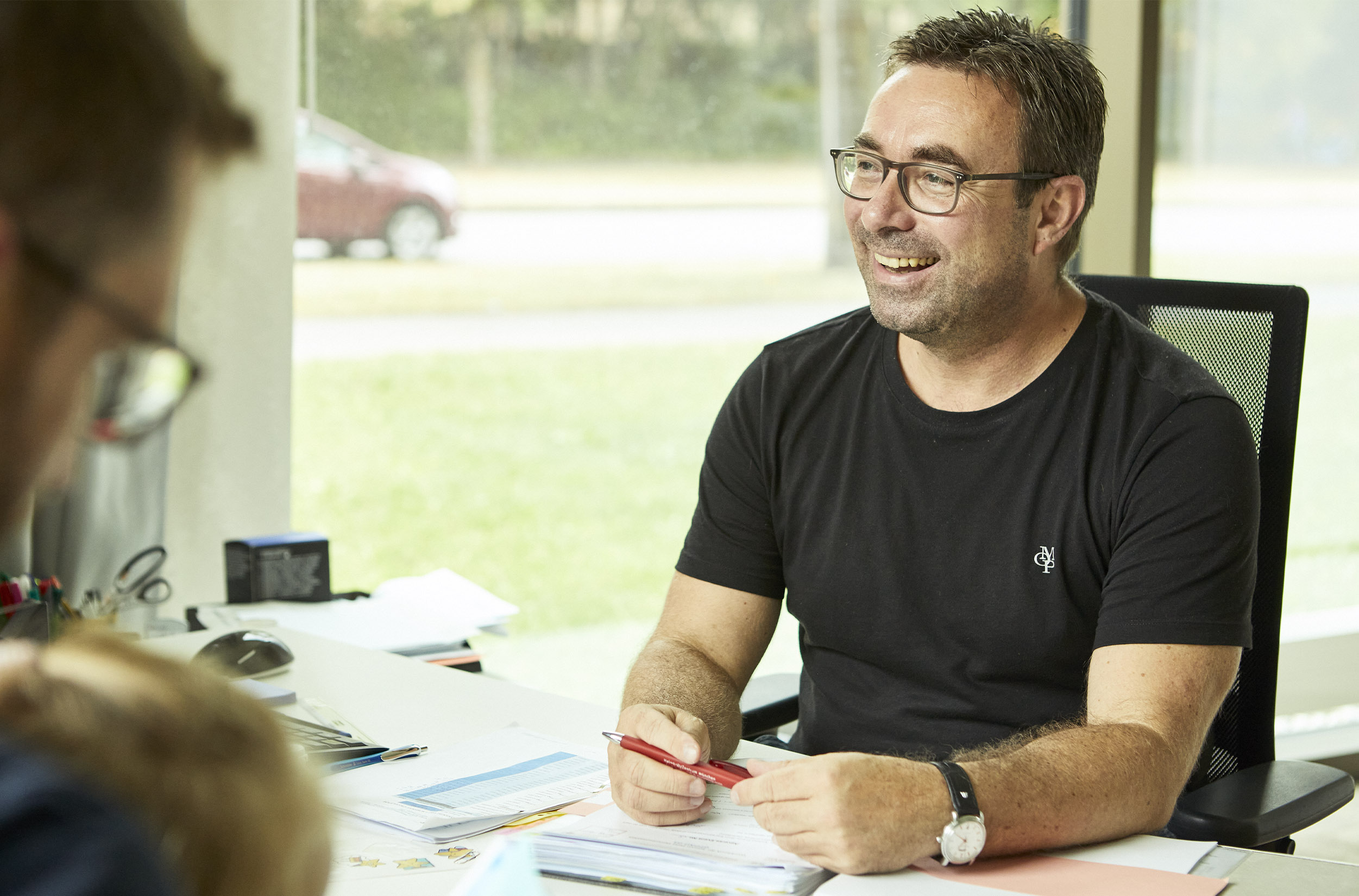
Type 1 diabetes can affect any child. Over 1.2 million children and adolescents worldwide have type 1 diabetes. More than half (54 percent) are under 15 years of age (IDF Atlas, 10th edition) – and the numbers are increasing, particularly in children under the age of five. If type 1 diabetes is not recognised in time, it can have serious consequences for the children. This is why we are raising awareness of what type 1 diabetes is and how you can recognise it in yourself or others.
People with type 1 diabetes have an autoimmune disease. This means that their immune system cannot always distinguish between foreign invaders (e.g. viruses or bacteria) and the body’s own cells. In type 1 diabetes, the immune system attacks the cells in the pancreas that are responsible for making insulin. The autoimmune reaction destroys the insulin-producing beta-cells. The body can then no longer produce insulin itself. As a result, people with type 1 diabetes have to take insulin several times a day to control their blood glucose levels. Insulin is transported via the bloodstream to the organs, where it enables the absorption of glucose (sugar) from the blood. Without insulin, the glucose in the blood cannot get into the cells of the organs and remains in the blood. As a result, blood glucose rises, and the cells are not supplied with enough energy.

What are the symptoms of type 1 diabetes?
In the early stages, type 1 diabetes usually goes unnoticed for a long time. The person initially feels healthy and does not have any symptoms. Signs appear when the insulin-producing cells in the pancreas stop making enough insulin and blood glucose rises.
Symptoms of type 1 diabetes
If symptoms occur in children or adolescents, a medical professional should check their blood glucose as soon as possible. In the worst case, if left untreated, it can lead to a serious metabolic imbalance known as diabetic ketoacidosis. If ketoacidosis occurs, the person needs to be monitored in hospital for some time, usually in an intensive care unit.
What is early-stage type 1 diabetes?
Before type 1 diabetes can be described in three different stages. In the early stages of type 1 diabetes there are no symptoms, but it can be diagnosed clinically. In the first stage (stage 1) an autoimmune process directed against the insulin-producing cells in the pancreas can be detected in the blood. In order to detect this autoimmune process, the blood is tested for so called islet autoantibodies. In the second stage (stage 2), a blood test called a ‘glucose tolerance test’ can be used to identify people with elevated blood glucose levels. The third stage (stage 3) is full-blown type 1 diabetes: the blood glucose is permanently high, and the symptoms mentioned above appear.
Is it possible to detect early-stage type 1 diabetes?
We do not normally routinely test well people for early-stage type 1 diabetes, however some people are tested for islet autoantibodies as part of research studies. An example is the Fr1da study conducted in Germany, which is the world's largest population-based screening for type 1 diabetes. The Fr1da study is active in the German federal states of Bavaria, Saxony and Lower Saxony. The screening test can identify type 1 diabetes before symptoms appear. This can prevent serious consequences for children affected and families can better prepare for the disease through training programmes.
What are the benefits of an early diagnosis of type 1 diabetes?
There are many benefits for patients and their families to identifying type 1 diabetes as early as possible. Firstly, it greatly reduces the number of times they will experience severe health issues such as metabolic imbalance and diabetic ketoacidosis. In addition, the function of the insulin-producing beta cells can be partially preserved if insulin therapy is started in good time, meaning that long-term regulation of blood glucose also works better. Overall, for children or adults affected, this can mean that they have shorter hospital stays, require less medical treatment and have fewer long-term consequences such as organ damage. This results in increased quality of life and longer life expectancy for people with type 1 diabetes.
Is type 1 diabetes inherited?
Most children who develop type 1 diabetes have no history if type 1 diabetes in their close family. A proportion of children do inherit a genetic predisposition to type 1 diabetes from their parents, however, children of parents with type 1 diabetes rarely develop the disease themselves. Three to four in 1,000 people will develop type 1 diabetes during their lifetime. This means that the risk of developing type 1 diabetes in the general population is 0.3–0.4%. If your mother has type 1 diabetes, your risk of developing the disease increases to 3%, and if your father has type 1 diabetes it increases to 5%. If two of your close relatives have type 1 diabetes (e.g. your mother and father, or a parent and sibling) your risk of type 1 diabetes increases to 25%. Additionally, there are certain genetic markers that either decrease or increase your risk of developing the disease. These are primarily the HLA genes. If you carry certain variants of these genes, they influence your personal genetic risk of developing type 1 diabetes.
What are the causes of type 1 diabetes?
Almost 90% of children who develop type 1 diabetes do not have a close relative with the disease. The onset of type 1 diabetes is influenced by several factors and genetic predisposition is just one of these factors. The exact causes of type 1 diabetes are not yet known. We know that the initial signs of the autoimmune disease often begin in the first two years of life. Viral infections in early childhood can increase the risk of developing type 1 diabetes. The bacteria in the gut (known as the microbiome) could also play a role. Children who later develop type 1 diabetes have a slightly different composition of gut bacteria to children who do not develop type 1 diabetes. Certain inflammatory markers are also detectable in the blood of children who later develop type 1 diabetes. At GPPAD, we research the causes of type 1 diabetes in various studies.
Is type 1 diabetes curable?
At the moment, there is no cure for type 1 diabetes. As insulin is essential for survival, people with type 1 diabetes must take insulin. The insulin is administered either via a pen or pump. People monitor their blood glucose level several times a day, either with a meter or continuously with the help of a sensor. In their daily planning, they must consider factors that affect blood glucose and adjust the amount of insulin accordingly. These factors include food and physical activity, but also things like infections and stress. If the treatment is not optimal, and the blood glucose level is too high over a longer period of time, long-term physiological damage can occur. Thanks to modern research, there are now initial interventions to delay the onset of type 1 diabetes. However, to do this, the disease must be detected in an early stage.
How can type 1 diabetes be prevented?
At the moment, there is no way to prevent the development of type 1 diabetes. However, we are conducting various studies to research new treatment options to delay or prevent the development of type 1 diabetes. With all of the interventions, our aim is to stop the body’s immune system from destroying the insulin-producing beta-cells. Ideally, as many beta-cells as possible are retained so that the body remains able to produce insulin itself. Teplizumab, the first drug that can delay the onset of type 1 diabetes by an average of two to three years, was approved in the US in November 2022. Our researchers are working hard to ensure that such therapies also become available in Europe.
What other interventions are there to prevent type 1 diabetes?
There are various approaches that aim to influence the autoimmune reaction that underlies type 1 diabetes. Overall, the goal is to train the immune system so that it does not attack the body’s own cells. In the POInT study (recruitment closed), for example, we are investigating whether the administration of insulin in powder form can train the immune system in children with an increased risk of type 1 diabetes. This could prevent the autoimmune reaction that leads to type 1 diabetes. In the SINT1A study (recruitment ongoing), infants with an increased risk of developing type 1 diabetes are given a probiotic. The aim here is for the bacteria in the probiotic to have a positive effect on the bacteria in the infant’s intestines and thereby regulate the immune system, preventing the disease-causing immune reaction. POInT and SINT1A are just two examples of a large number of studies aiming to prevent type 1 diabetes.
What is life with type 1 diabetes like?
Children and people with type 1 diabetes need regular insulin injections. They deal with their condition as they go about their everyday life, always actively monitoring their blood glucose. They have to take over the job, that is usually done automatically by one of our organs, the pancreas. For this, we consider them Hero K1ds. Thanks to modern developments, people with type 1 diabetes can now live their lives like other people. You can find stories about our big and little heroes on our blog.
Where can I find more information?
Further information on type 1 diabetes and other types of diabetes can be found on the diabetes information platform www.DiabInfo.de, which is provided by Helmholtz Munich, the German Center for Diabetes Research (DZD) and the German Diabetes Center. You can find more information about our studies on the information page or at www.gppad.org.
Did you know these facts about Type 1 Diabetes as shown by the latest research?
Did you know that more than 40 % of people with type 1 diabetes develop the disease before the age of 20? [1]
Did you know that a simple blood test can identify newborns with a genetic risk greater than 10% of developing type 1 diabetes? [2]
Did you know that 3 in 1,000 children have undiagnosed early-stage type 1 diabetes? [3]
Did you know that a screening test for type 1 diabetes would only cost the German healthcare system 22 euros per child? [4]
Did you know that during the COVID-19 pandemic, the incidence of new-onset type 1 diabetes increased by 15%? [5]
Did you know that the length of time babies are breastfed has no impact on the development of type 1 diabetes? [6]
Did you know that children born to mothers with type 1 diabetes not only have significantly higher risk of the disease itself, but also of obesity and insulin resistance? [7]
Did you know that the risk of developing the autoimmune disease type 1 diabetes is highest in the first few years of life and decreases exponentially with age? [8]
Did you know that infants and young children who develop islet autoantibodies already have slightly higher blood glucose levels? [9]


Der Deutsche Diabetiker Bund e.V. (DDB) ist die älteste und eine der größten Patienten-Selbsthilfeorganisation für Menschen, die von Diabetes betroffen sind, und ein kompetenter Ansprechpartner in Sachen Diabetes. Der Bundesverband, 5 Landesverbände, 3 Regionalverbände bilden den DDB, der vehement gegen Einschnitte in der Diabetesversorgung und für die Verbesserung der Lebenssituation der Betroffenen kämpft. Der DDB ist die einzige ausschließlich patientenorientierte Organisation, die die Interessen der Betroffenen in Politik und Gesellschaft insbesondere als akkreditiertes Mitglied der Patientenbeteiligung im Gemeinsamen Bundesausschuss wahrnimmt.
© Institut für Diabetesforschung – Helmholtz Munich 2023
